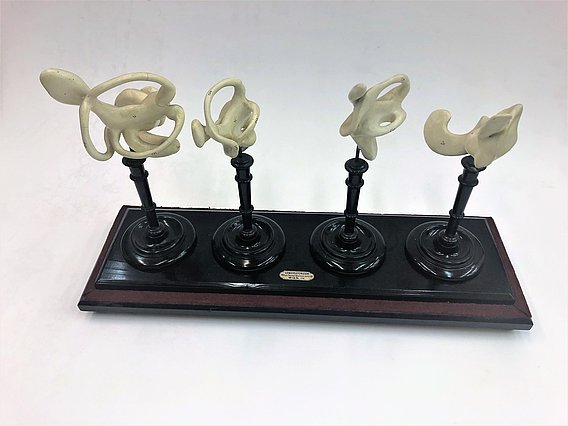Developmental series of the inner ear

The model was created following a design by Joseph Hyrtl. It was manufactured and created by the company Lenoir & Forster from Vienna IV (see [1]). The parts of the models can be set up, describing the development of the human inner ear. The company was well known for its contribution to the scientific world through the spread of macroscopic objects, microscopes, lab equipment and chemicals (compare [2]).
The introduction of scientific models is always advisable when it is necessary to simplify complicated situations or to represent known and unknown partial knowledge in a model together, so it was evident, that the demand for scientific representation was rising in the second half of the Nineteenth Century. Fostered by new discoveries in all scientific disciplines (hear represented in objects on embryology) a plethora of different companies (compare [3]) could arise, being recognized by the general public at the different world and centennial exhibitions (see [4]).
The development of the inner ear has been studied intensively at the time of the object’s making, but the bigger picture was not yet clear. Only in recent years the scientific community could reconcile the different theories, and although it seems obvious that the ability to process nearby sounds would be enormously useful, modern amniote ears in fact arose quite late in evolutionary history, and to a large extent independently in different lineages. As a result, external, middle, and inner ears of various amniotes are characteristically different [5]. The combined research efforts of paleontologists, texonomists, anatomists, physiologists, and developmental biologists over several decades have clarified the major evolutionary steps that modified the malleable middle and inner ears into their present-day kaleidoscopic variety of form, yet a surprising consensus in their function [6]
References
- Rosenbauer, K. A. (2003). Mikroskopische Präparate (Vol. 1). John Wiley & Sons.
- Sedivy, R. (2007). Geschichte pathologischanatomischer Sammlungen. Pathologie in Fallstudien: Historische Präparate neu betrachtet, 7-28.
- von Schlosser, J. R., Davis, W., Didi-Huberman, G., Hecker, S., Kornmeier, U., & Massey, L. (2008). Ephemeral bodies: wax sculpture and the human figure. Getty Publications.
- Dittrich, K. (2010). Experts going transnational: education at world exhibitions during the second half of the nineteenth century (Doctoral dissertation, University of Portsmouth, Portsmouth, United Kingdom).
- Manley, G. A., & Köppl, C. (1998). Phylogenetic development of the cochlea and its innervation. Current opinion in neurobiology, 8(4), 468-474.
- Manley, G. A. (2017). Comparative auditory neuroscience: understanding the evolution and function of ears. Journal of the Association for Research in Otolaryngology, 18(1), 1-24.




